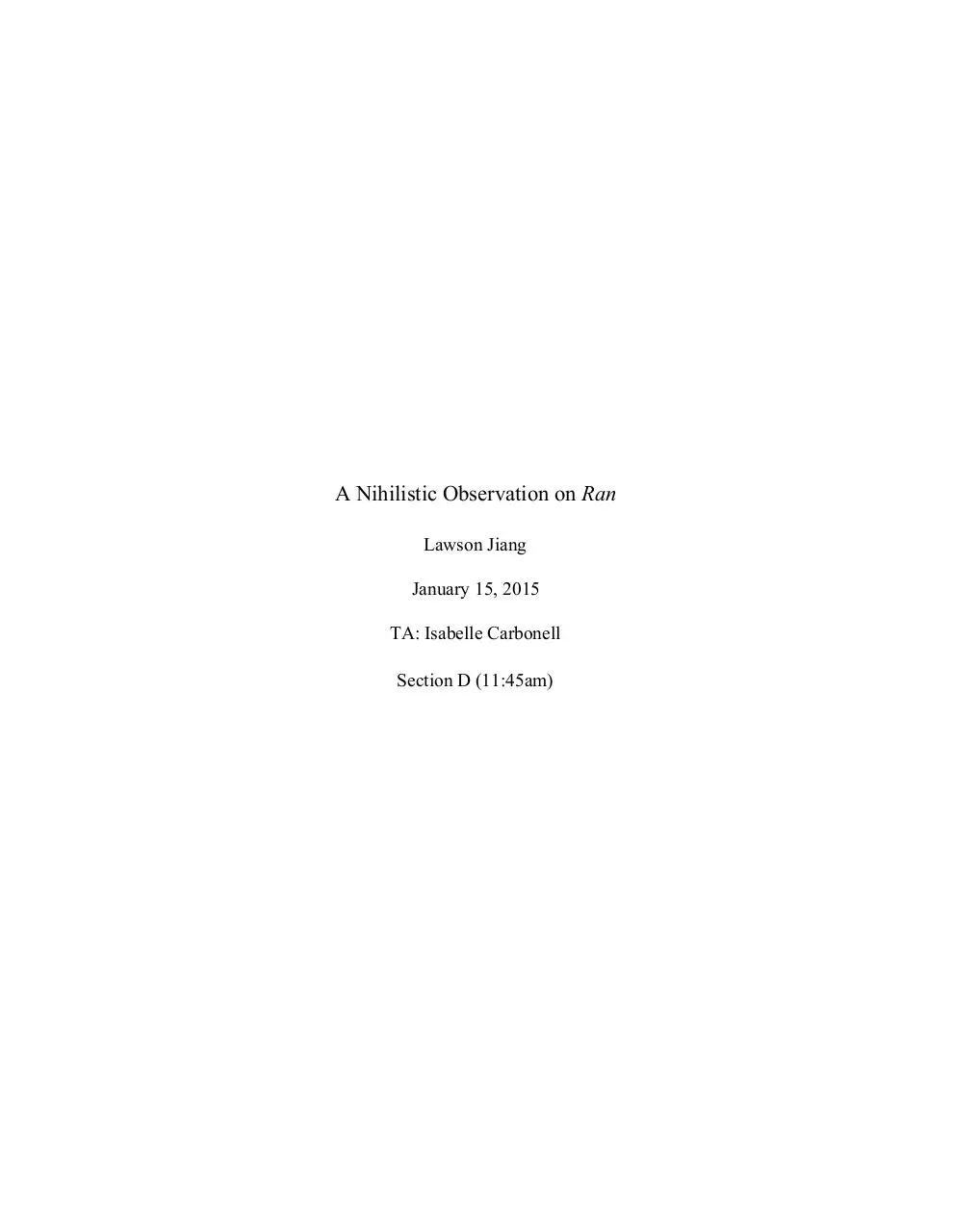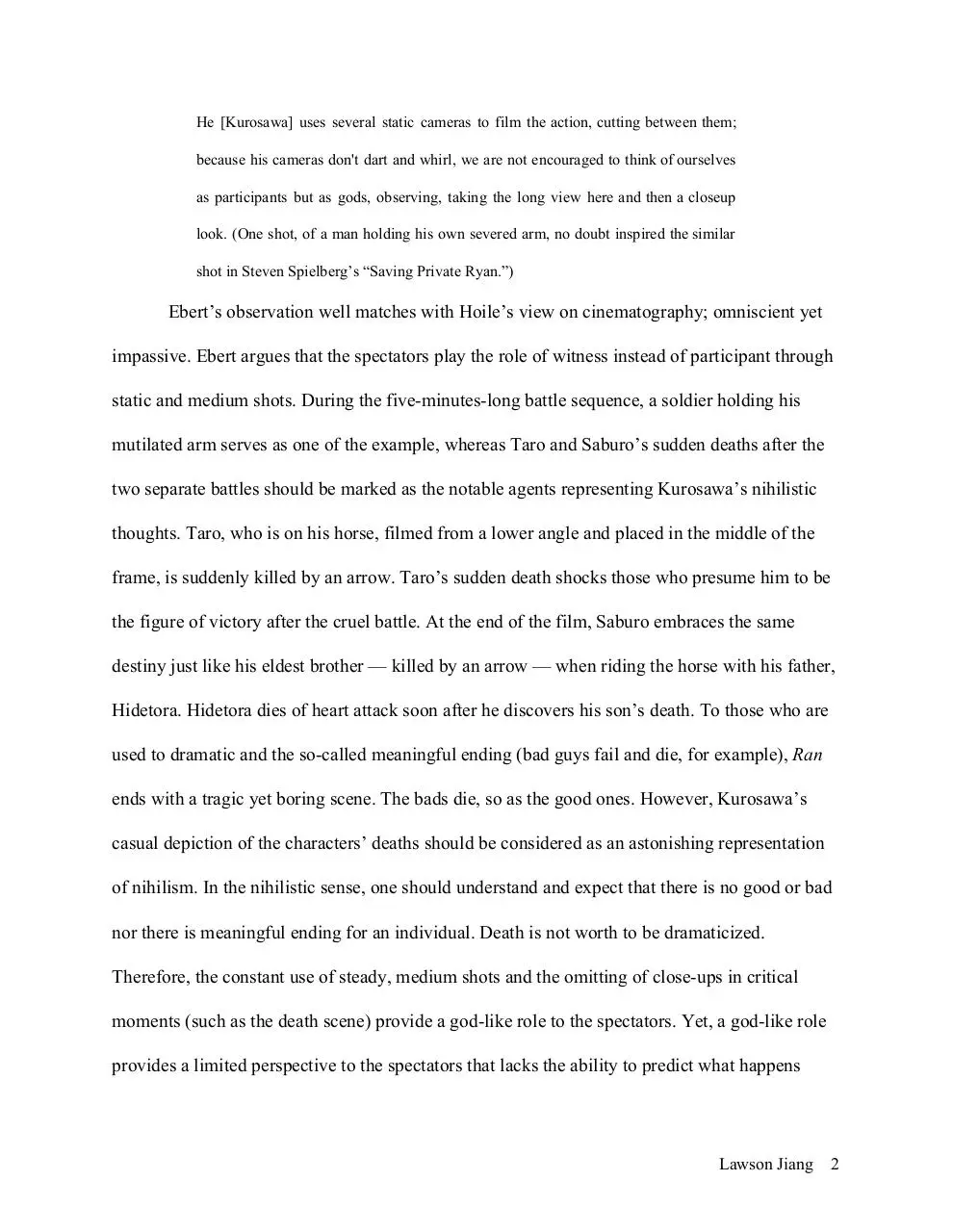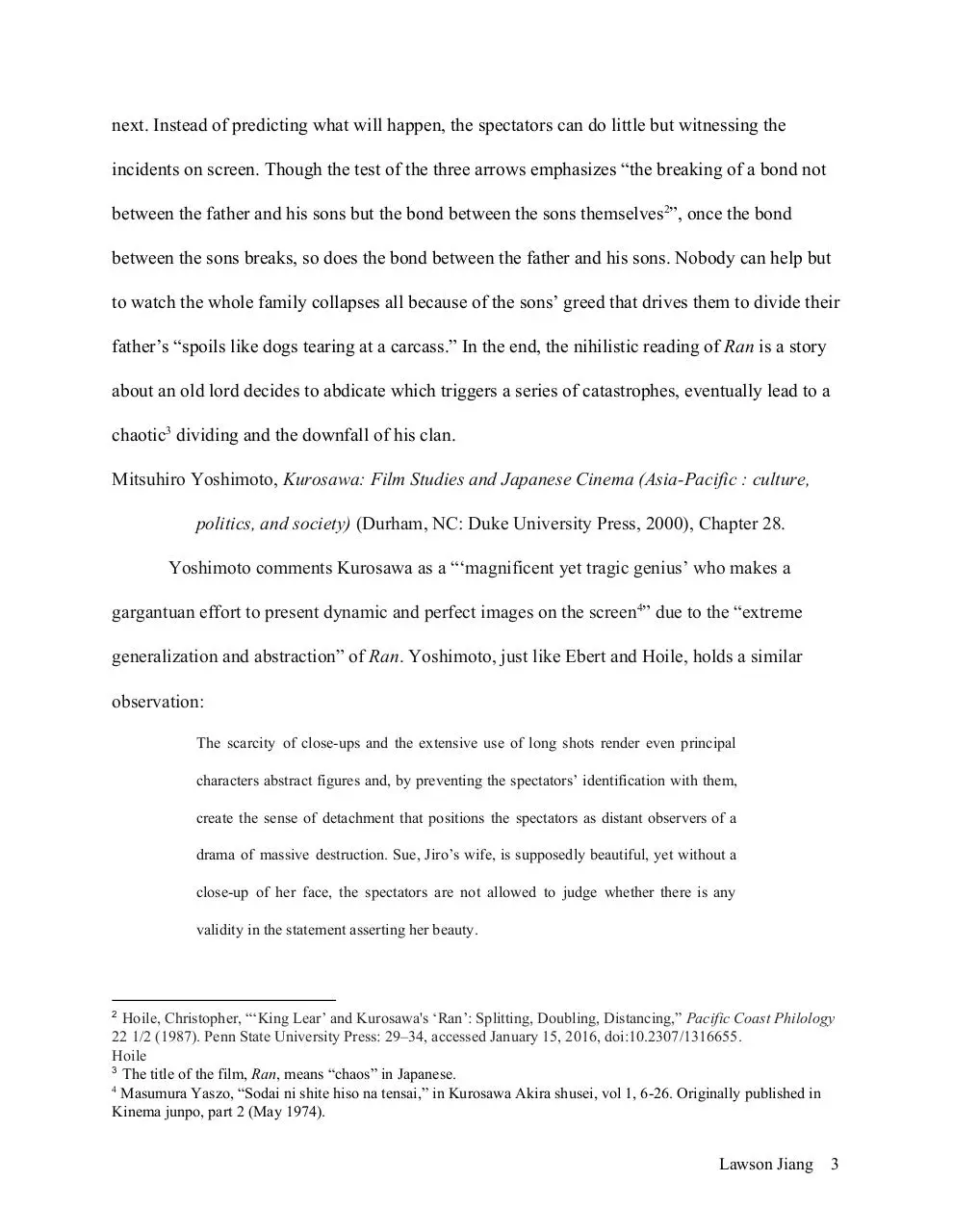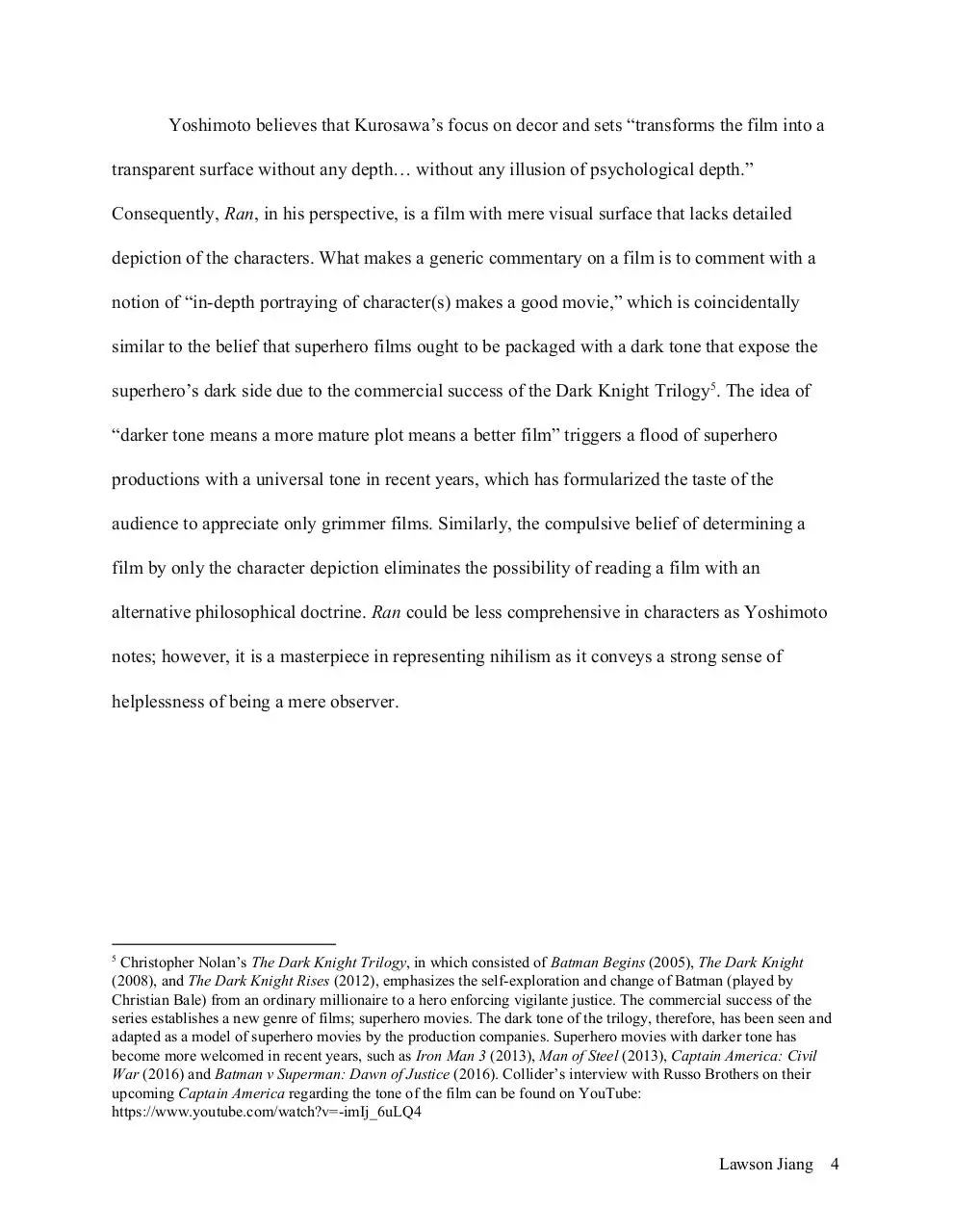A Nihilistic Observation on Ran (PDF)
File information
This PDF 1.5 document has been generated by / Skia/PDF, and has been sent on pdf-archive.com on 06/04/2016 at 08:27, from IP address 169.233.x.x.
The current document download page has been viewed 611 times.
File size: 146.55 KB (5 pages).
Privacy: public file





File preview
A Nihilistic Observation on
Ran
Lawson Jiang
January 15, 2015
TA: Isabelle Carbonell
Section D (11:45am)
Hoile, Christopher, “‘King Lear’ and Kurosawa's ‘Ran’: Splitting, Doubling, Distancing,”
Pacific Coast Philology
22 1/2 (1987). Penn State University Press: 29–34, accessed
January 15, 2016, doi:10.2307/1316655.
Hoile compares and evaluates the similarities and differences between Shakespeare’s
King Lear
and Kurosawa’s
Ran
. Through comparing the plots of the two epic works, Hoile
thoroughly presents to whom are interested in discovering the relationship between the two
work, such as the character settings and the similaryetdifferent plot structure as he points out
that “the test of the three arrows replaces the lovetest in King Lear, but it is not equivalent to it”
(p.30). While a majority of the articles found during the research focus on addressing how
Kurosawa’s film is similar to
King Lear
— with detailed analysis of each characters in
Ran
to
their correspondents in
King Lear —
Hoile brings up something different that makes his work
stands out among the rest of the analytical essays, the cinematography of the film. He, however,
talks about the cinematography with only a sentence commenting that the camera is “an
impassive and literally distant observer” (p.29). Although his comment should include a more
elaborate analysis from the cinematographic aspect, the short comment establishes a brand new
idea that
Ran
carries a nihilistic tone throughout the entire film. This notion is also addressed in
Roger Ebert’s updated review1 published on his blog in October 1, 2000.
Roger Ebert, “Ran Movie Review & Film Summary (1985),” Roger Ebert (blog), October 1,
2000, http://www.rogerebert.com/reviews/greatmovieran1985
The notion of Nihilism brought up by Hoile receives a more detailed and interesting
interpretation in film critic Roger Ebert’s review. Ebert writes:
Roger Ebert, “Ran Movie Review & Film Summary (1985),” Roger Ebert (blog), October 1, 2000,
http://www.rogerebert.com/reviews/greatmovieran1985. There are two entries of review by Roger Ebert, the first
was published in 1985 and the updated was in 2000.
1
Lawson Jiang
1
He [Kurosawa] uses several static cameras to film the action, cutting between them;
because his cameras don't dart and whirl, we are not encouraged to think of ourselves
as participants but as gods, observing, taking the long view here and then a closeup
look. (One shot, of a man holding his own severed arm, no doubt inspired the similar
shot in Steven Spielberg’s “Saving Private Ryan.”)
Ebert’s observation well matches with Hoile’s view on cinematography; omniscient yet
impassive. Ebert argues that the spectators play the role of witness instead of participant through
static and medium shots. During the fiveminuteslong battle sequence, a soldier holding his
mutilated arm serves as one of the example, whereas Taro and Saburo’s sudden deaths after the
two separate battles should be marked as the notable agents representing Kurosawa’s nihilistic
thoughts. Taro, who is on his horse, filmed from a lower angle and placed in the middle of the
frame, is suddenly killed by an arrow. Taro’s sudden death shocks those who presume him to be
the figure of victory after the cruel battle. At the end of the film, Saburo embraces the same
destiny just like his eldest brother — killed by an arrow — when riding the horse with his father,
Hidetora. Hidetora dies of heart attack soon after he discovers his son’s death. To those who are
used to dramatic and the socalled meaningful ending (bad guys fail and die, for example),
Ran
ends with a tragic yet boring scene. The bads die, so as the good ones. However, Kurosawa’s
casual depiction of the characters’ deaths should be considered as an astonishing representation
of nihilism. In the nihilistic sense, one should understand and expect that there is no good or bad
nor there is meaningful ending for an individual. Death is not worth to be dramaticized.
Therefore, the constant use of steady, medium shots and the omitting of closeups in critical
moments (such as the death scene) provide a godlike role to the spectators. Yet, a godlike role
provides a limited perspective to the spectators that lacks the ability to predict what happens
Lawson Jiang
2
next. Instead of predicting what will happen, the spectators can do little but witnessing the
incidents on screen. Though the test of the three arrows emphasizes “the breaking of a bond not
between the father and his sons but the bond between the sons themselves2”, once the bond
between the sons breaks, so does the bond between the father and his sons. Nobody can help but
to watch the whole family collapses all because of the sons’ greed that drives them to divide their
father’s “spoils like dogs tearing at a carcass.” In the end, the nihilistic reading of
Ran
is a story
about an old lord decides to abdicate which triggers a series of catastrophes, eventually lead to a
chaotic3 dividing and the downfall of his clan.
Mitsuhiro Yoshimoto,
Kurosawa: Film Studies and Japanese Cinema (AsiaPacific : culture,
politics, and society)
(Durham, NC: Duke University Press, 2000), Chapter 28.
Yoshimoto comments Kurosawa as a “‘magnificent yet tragic genius’ who makes a
gargantuan effort to present dynamic and perfect images on the screen4” due to the “extreme
generalization and abstraction” of
Ran
. Yoshimoto, just like Ebert and Hoile, holds a similar
observation:
The scarcity of closeups and the extensive use of long shots render even principal
characters abstract figures and, by preventing the spectators’ identification with them,
create the sense of detachment that positions the spectators as distant observers of a
drama of massive destruction. Sue, Jiro’s wife, is supposedly beautiful, yet without a
closeup of her face, the spectators are not allowed to judge whether there is any
validity in the statement asserting her beauty.
Hoile, Christopher, “‘King Lear’ and Kurosawa's ‘Ran’: Splitting, Doubling, Distancing,”
Pacific Coast Philology
22 1/2 (1987). Penn State University Press: 29–34, accessed January 15, 2016, doi:10.2307/1316655.
Hoile
3
The title of the film,
Ran
, means “chaos” in Japanese.
4
Masumura Yaszo, “Sodai ni shite hiso na tensai,” in Kurosawa Akira shusei, vol 1, 626. Originally published in
Kinema junpo, part 2 (May 1974).
2
Lawson Jiang
3
Yoshimoto believes that Kurosawa’s focus on decor and sets “transforms the film into a
transparent surface without any depth… without any illusion of psychological depth.”
Consequently,
Ran
, in his perspective, is a film with mere visual surface that lacks detailed
depiction of the characters. What makes a generic commentary on a film is to comment with a
notion of “indepth portraying of character(s) makes a good movie,” which is coincidentally
similar to the belief that superhero films ought to be packaged with a dark tone that expose the
superhero’s dark side due to the commercial success of the Dark Knight Trilogy5. The idea of
“darker tone means a more mature plot means a better film” triggers a flood of superhero
productions with a universal tone in recent years, which has formularized the taste of the
audience to appreciate only grimmer films. Similarly, the compulsive belief of determining a
film by only the character depiction eliminates the possibility of reading a film with an
alternative philosophical doctrine.
Ran
could be less comprehensive in characters as Yoshimoto
notes; however, it is a masterpiece in representing nihilism as it conveys a strong sense of
helplessness of being a mere observer.
Christopher Nolan’s
The Dark Knight Trilogy
, in which consisted of
Batman Begins
(2005),
The Dark Knight
(2008), and
The Dark Knight Rises
(2012), emphasizes the selfexploration and change of Batman (played by
Christian Bale) from an ordinary millionaire to a hero enforcing vigilante justice. The commercial success of the
series establishes a new genre of films; superhero movies. The dark tone of the trilogy, therefore, has been seen and
adapted as a model of superhero movies by the production companies. Superhero movies with darker tone has
become more welcomed in recent years, such as
Iron Man 3
(2013),
Man of Steel
(2013),
Captain America: Civil
War
(2016) and
Batman v Superman: Dawn of Justice
(2016). Collider’s interview with Russo Brothers on their
upcoming
Captain America
regarding the tone of the film can be found on YouTube:
https://www.youtube.com/watch?v=imIj_6uLQ4
5
Lawson Jiang
4
Download A Nihilistic Observation on Ran
A Nihilistic Observation on Ran.pdf (PDF, 146.55 KB)
Download PDF
Share this file on social networks
Link to this page
Permanent link
Use the permanent link to the download page to share your document on Facebook, Twitter, LinkedIn, or directly with a contact by e-Mail, Messenger, Whatsapp, Line..
Short link
Use the short link to share your document on Twitter or by text message (SMS)
HTML Code
Copy the following HTML code to share your document on a Website or Blog
QR Code to this page

This file has been shared publicly by a user of PDF Archive.
Document ID: 0000357642.